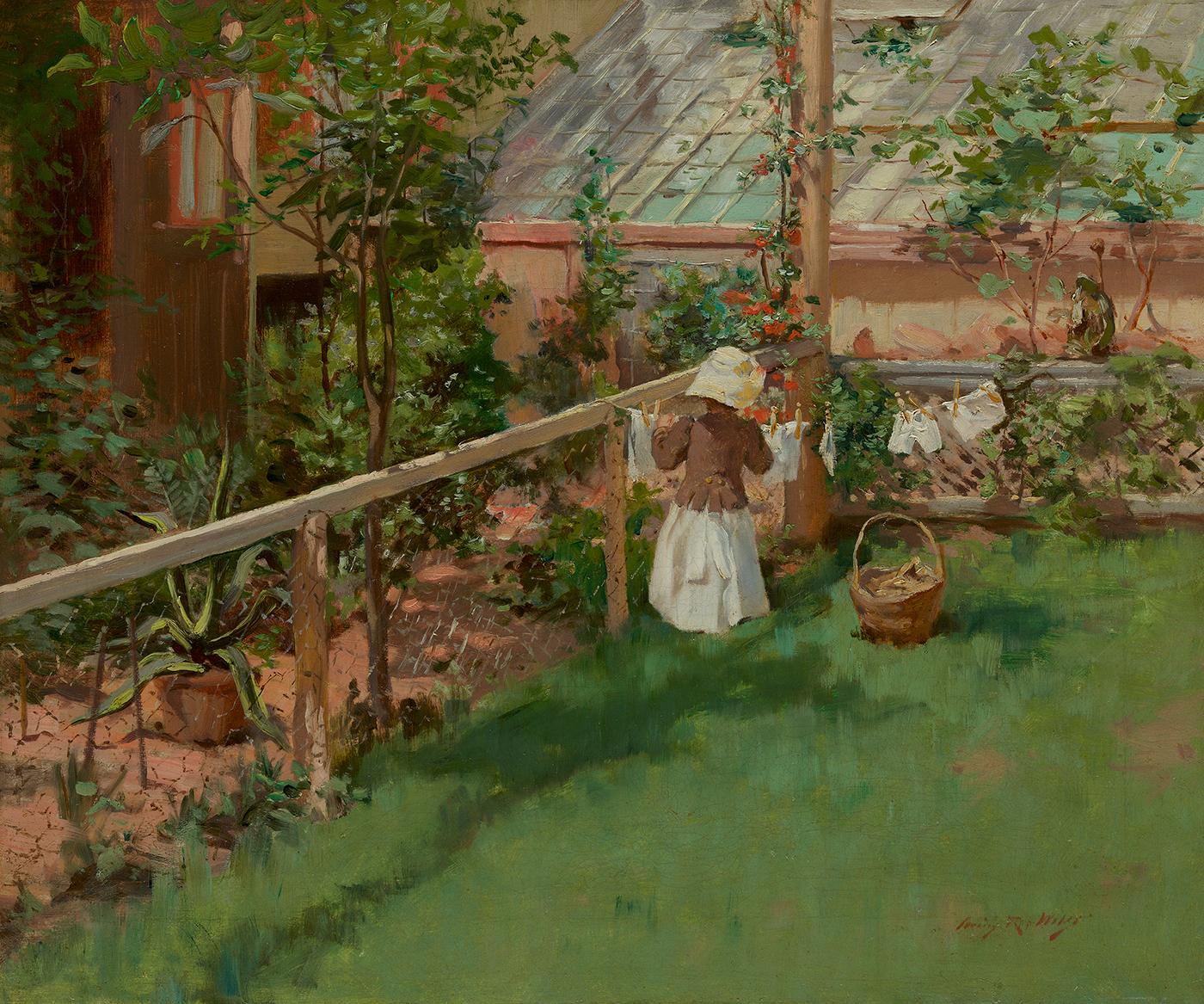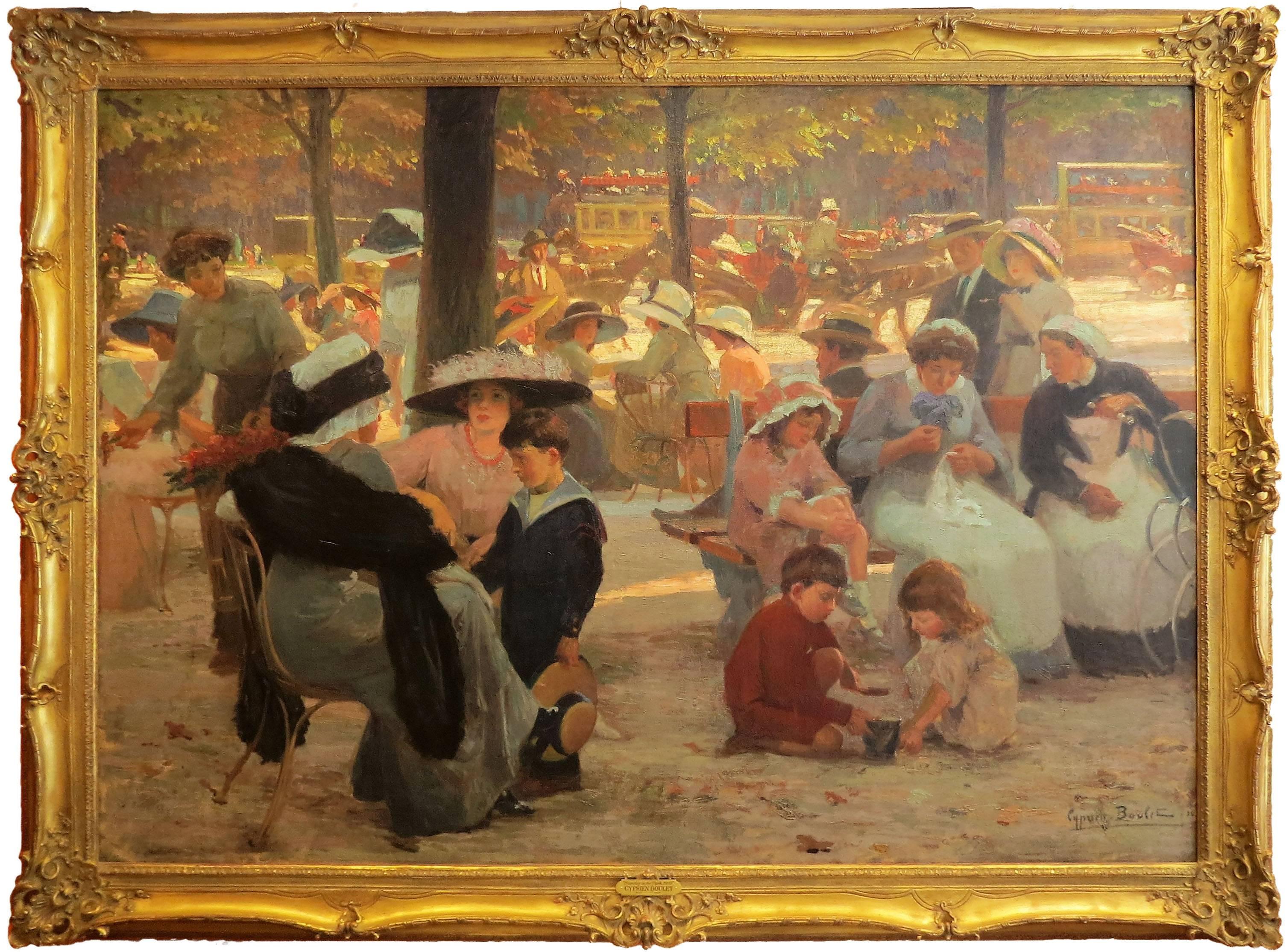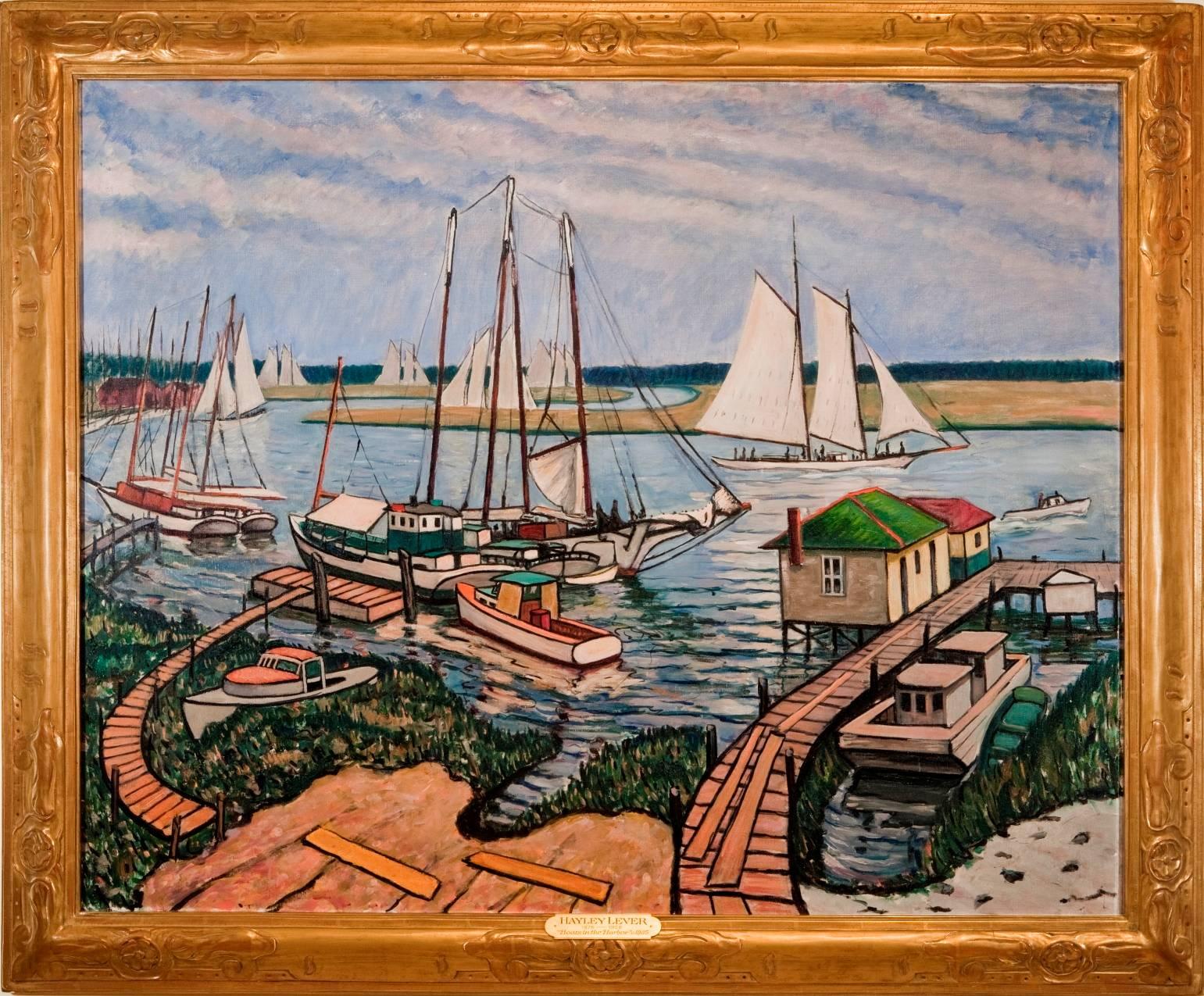Jose Vives-Atsara"HOUSES ON THE HILLS" CATALONIA SPAIN. DATED 19811981
1981
About the Item
- Creator:Jose Vives-Atsara (1919 - 2004, American)
- Creation Year:1981
- Dimensions:Height: 34 in (86.36 cm)Width: 39 in (99.06 cm)Depth: 3 in (7.62 cm)
- More Editions & Sizes:Image Size: 24 x 30Price: $20,700
- Medium:
- Movement & Style:
- Period:
- Framing:Frame IncludedFraming Options Available
- Condition:Please visit my 1stdibs storefront for other Texas & American, paintings, pottery, & more. We ship worldwide.
- Gallery Location:San Antonio, TX
- Reference Number:1stDibs: LU769313442362
Jose Vives-Atsara
Jose Vives-Atsara was born in Vilafranca del Panades in the Catalonian region of Spain on April 30, 1919.. As a small boy he loved to sketch with pencil and paper. He developed a love of painting at an early age, and by age 11 had committed himself to becoming an artist. He studied at Colegio de San Ramón and had his first one-person show at age 14. Jose studied art at Saint Raymond College and School of Fine Arts in Barcelona. He has admitted that his most inspirational teacher has been nature itself. Mr. Vives-Atsara went to San Antonio in 1956 where he established his art career.
The Spanish Civil War interrupted his idyllic young life as he was forced to serve in the Communist Army, and then was imprisoned, suffering many hardships. Soon after the war, he married Emilia Hill Domenech, and in 1947 set out to move with his wife and child aboard a tramp steamer to the United States. Unfortunately, immigration quotas did not allow them to move directly to the United States, and it was eight years before they achieved that goal. During this interim before obtaining temporary visas, he and his family lived first, in Caracas, Venezuela and then in Mexico City, Mexico. The family settled in San Antonio, Texas, where he had made friends on a previous visit. He and his wife and children gained citizenship in time for their first Christmas in the United States. He became such an exemplary immigrant citizen that officials of the U.S. District Court for the Western District Court regularly invited him to share his thoughts and advice for living in America with newly naturalized citizens. Vives-Atsara also developed a close relationship with the Incarnate Word College, becoming, over the years, both a professor of art, and Artist in Residence.
As a painter, he depicted many local scenes including San Antonio missions and the San Antonio River. For special guests such as Pope John Paul II, heads of state, and royalty from foreign countries, he was commissioned to provide paintings as gifts. His paintings were also commissioned for Frost Bank and the San Antonio Chamber of Commerce. For his vibrant oil paintings, he used only nine colors, mixed in a variety of ways. They have been described as both realistic and impressionistic. "Vives-Atsara believed that art is a reflection of the artist's soul, if this is true; his paintings reflect a beautiful, bright spirit." (Richardson).
Jose Vives-Atsara’s use of a palette knife in painting allowed him to blend rich pure pigments to achieve his goal of creating a powerful statement of color directly on the canvas. This style is intended to produce works that are distinctively Vives-Atsara. Vives-Atsara is represented in public collections including the Museum of Modern Art, Spain; Fort Worth Art Museum, Texas; His Royal Highness Juan Carlos, King of Spain; the Vatican; the State Capitals of many southern states of the United States. His focus was on depicting the character of the people of Mexico, colorful and strong florals and his Texas landscapes, which he regards as breathtaking. Vives-Atsara considers himself fortunate in his ability to approach, even in a small way, the wonders that God has offered to man. For more than 40 years, hard work and discipline have been his way of life. According to him “discipline in our lives is something that we sometimes do not like today, but helps us achieve what we really want tomorrow. Jose Vives-Atsara died in San Antonio on January 13, 2004, and is buried there in Sunset Memorial Park Mausoleum.
- ShippingRetrieving quote...Ships From: San Antonio, TX
- Return PolicyThis item cannot be returned.
- " Summer Evening Southwest Texas " 1909 Texas Hill CountryBy Julian OnderdonkLocated in San Antonio, TXJulian Onderdonk "Summer Evening S. W. Texas" Texas Hill Country (1882 - 1922) San Antonio Artist Image Size: 9 x 12 Frame Size: 15 x 18 Medium: Oil on panel Dated 1909 "Summer Evening S. W. Texas" "A Texas Painter Worked Under the Radar in New York," By Eve M. Kahn, March 6, 2014, The New York Times Onderdonk, a San Antonio native who died of an intestinal ailment in 1922, at 40, is best known for painting swaths of Texas bluebonnets. Those canvases can bring more than $500,000 each, while his New York scenes usually end up in the five-figure range. Onderdonk’s parents were painters in San Antonio, and in 1901, when he was a teenager, they sent him to New York for training. Through 1909, he lived in various Manhattan apartments and Staten Island houses. He then returned to Texas, but continued to spend months at a time in New York. In 1902 he had married a Manhattan teenage neighbor, Gertrude Shipman. While she focused on raising their daughter, Adrienne, and worrying about their strained finances, “he created more than 600 works of art, often producing a painting or two a day,” Eyewitnesses recorded his prolific pace in New York, but Onderdonk works bearing those dates rarely turn up. The puzzling gap in his productivity is explained in family correspondence that the Bakers uncovered: The artist admits that he was signing pieces with pseudonyms. He mostly used Chas. Turner and Chase Turner and occasionally resorted to Elbert H. Turner and Roberto Vasquez. Julian Onderdonk was the son of the important Texas landscapist, Robert Onderdonk. He was the father's pupil at age 16. Sponsored by a Texas patron, he studied at the Art Students League in New York when he was 19, the pupil of Kenyon Cox, Frank DuMond, and Robert Henri. He also studied with William Merritt Chase on Long Island. In 1902, having lost his Texas patron because he married, he asked $18 for 12 paintings at a Fifth Avenue dealer in New...Category
Early 1900s Impressionist Landscape Paintings
MaterialsOil
- "IN THE LAND OF THE SPANISH OAK " TEXAS HILL COUNTRY DATED 1910By Julian OnderdonkLocated in San Antonio, TXJulian Onderdonk (1882 - 1922) San Antonio Artist Image Size: 20 x 30 Frame Size: 29 x 39 Medium: Oil Dated 1910 "In The Land Of The Spanish Oak" Spectacular larger scene by Julian...Category
1910s Impressionist Landscape Paintings
MaterialsOil
- "Brackenridge Park" San Antonio Texas.By Jose ArpaLocated in San Antonio, TXJose Arpa (1858-1952) San Antonio Artist Image Size: 18 x 24 Frame Size: 21 x 27 Medium: Oil Circa 1920s "Brackenridge Park" San Antonio Texas. Biography Jose Arpa (1858-1952) Born in Carmona, Spain, José Arpa y Perea was known as "The Colorist Painter" of figures and landscapes, especially in Texas where he brought a fresh approach to San Antonio painting in his bright, sunlit local scenes. He was also an etcher, illustrator, and muralist as well as an art teacher, and he started and ended his career in Spain. His subjects include the Grand Canyon of Arizona. Please visit our 1stdibs storefront to view more of our fabulous goodies. He began his art study as the pupil of Eduardo Cano de la Pena at the Academy of Fine Arts in Seville and then spent six years in Rome followed by extensive travel through Africa and Europe. His reputation was solid enough that the Spanish government sent four of his paintings as part of the exhibition to the 1893 World's Columbian Exposition in Chicago. In 1894, as an illustrator, he accompanied a Spanish army expedition to Morocco where the Spanish had been defeated by Rifi tribesmen. In the mid-1890s, he was brought to Mexico City, reportedly by a special Mexican naval vessel, to head the Academy of Fine Arts, but declined the position once he understood the responsibilities. Instead he joined one of his Spanish schoolmates and went to his home in Puebla, Mexico, where his use of bright colors earned him the name of "Sunshine Man." He became close to the children of this man, and in 1903, accompanied them as a guardian to school in San Antonio. After twenty years of traveling in Spain, Mexico, the Southwest, and South America, Arpa settled in 1923 in San Antonio, Texas, where he became Director of the San Antonio Art School and painted bright, sun-filled landscapes. He taught landscape and portrait painting and was exceedingly prolific, and several San Antonio collectors accumulated large numbers of his works. Among his close artist friends were Robert and Julian Onderdonk, Tom and Joe Brown, and Charles Simmang. They were members of a San Antonio group who painted together and called themselves the "Brass Mug...Category
1920s Impressionist Landscape Paintings
MaterialsOil
- "STAGING ON THE SOUTHERN ARIZONA TRAIL" STAGECOACH ARIZONA / CALIFORNIABy Marjorie ReedLocated in San Antonio, TXMarjorie Reed a.k.a. Harvey Day (1915-1996) California, Arizona Artist Image Size: 16 X 20 Frame Size: 22 X 26 Medium: Oil on Canvas "Valley of the Monuments"Category
20th Century Impressionist Landscape Paintings
MaterialsOil
- "CAREFREE" WESTERN, COWBOYS, HORSES, CATTLE, PRICKLY PEAR CACTUS (1921-1990)By James BorenLocated in San Antonio, TXJames Boren (1921 - 1990) Waxahatchie, Texas / Oklahoma Artist / Member Cowboy Artists of America Image Size: 28 x 42 Frame Size: 40 x 53 Medium: Oil "Ca...Category
1970s Impressionist Landscape Paintings
MaterialsOil
- "APRIL" TEXAS HILL COUNTRY BLUEBONNETS IMAGE: 25 X 30 FRAME: 33 X 38 CIRCA 1940SLocated in San Antonio, TXRobert Wood (G. Day) (1889 -1979) San Antonio Artist Image Size: 25 x 30 Frame Size: 33 x 38 Medium: Oil "April" Texas Hill Country Bluebonnets Biography Robert Wood (G. Day) (1889 -1979) A painter of realistic landscapes reflecting a vanishing wilderness in America, Robert Wood (not to be confused with Robert E. Wood) is reportedly one of the most mass-produced artists in the United States. His painting became so popular he was unable to meet all of the demands, and many of his works were reproduced in lithographs and mass distributed as prints, place mats, and wall murals by companies including Sears, Roebuck. He was born in Sandgate, Kent on the south coast of England near Dover, the son of W.L. Wood, a famous home and church painter who recognized and supported his son's talent. In fact, he forced his son to paint by keeping him inside to paint rather than playing with his friends. At age 12, Wood entered the South Kensington School of Art. As a youth, he came to the United States in 1910, having served in the Royal Army, and he never returned to England. He traveled extensively all over the United States, especially in the West, often in freight cars, and also painted in Mexico and Canada. His itinerant existence took him to Illinois where he worked as a farmhand, to Pensacola, Florida where he married, briefly in Ohio, Seattle, Washington, and Portland, Oregon. In 1912, he was in Los Angeles, and in the late 1920s and early 1930s, in San Antonio, Texas, where he lived and in 1928 exhibited in the "Texas Wildflower Competition." From San Antonio, he gained a national reputation for his strong colored, dramatic paintings. Some of that prestige has been credited to his association with Jose Arpa, prominent Texas artist. Wood also gave art lessons, and one of his students was Porfirio Salinas. During this period, Wood sometimes signed his paintings G. Day or Trebor, which is Robert spelled backwards. In 1941 he went to California and painted numerous desert and mountain landscapes and coastal scenes. He lived in Carmel for seven years, and then moved to Woodstock, New York, but he soon returned to California, settling first in Laguna Beach, then San Diego, and finally in the High Sierras, where he and his wife built a home and studio near Bishop and lived until his death in 1979. Robert Wood was born March 4, 1889, in Sandgate, England, a small town on the Kentish coast not far from the white cliffs of Dover. His father, W. J. Wood, was a successful painter who recognized Robert's unusual talent. At the age of twelve, his father enrolled Wood in art school in the small town of Folkstone. He then attended the South Kensington School of Art. While attending art school, Wood won four first awards and three second awards, one each year, a record. In 1910 after service in the Royal Army, nineteen-year-old Wood and his friend, Claude Waters, immigrated to America. Initially, he settled in Illinois and worked as a hired hand on a farm belonging to Water's uncle. He would then strike out on his own, living the life of an itinerant painter. Wood traveled as a hobo, hopping freight trains and selling or bartering small paintings to support him along the way. When times were hard, he worked at whatever job was available. In this manner, he saw most of the United States and fell in love with rural America. By 1912, Wood visited Los Angeles for the first time, arriving on the day of the Titanic tragedy. Later that year, he had met, courted and married young Eyssel Del Wagoner in Florida. The couple moved to Ohio where a daughter, Florence, was born. During World War I, the family moved to Seattle where a son, John Robert Wood, was born in 1919. In the early 1920's, the young Wood family was almost constantly on the move. They stayed for short periods in Kansas, Missouri, California and for a longer time in Portland, Oregon, where Wood's friend Claude Waters had settled. Wood's seemingly endless wanderings disrupted his family life and delayed his development as a painter. However, through his travels he developed an appreciation for the American landscape that would inspire him for the rest of his career. Although aware of the current movement away from traditional realism in American art, he elected to travel that solitary path and remain true to his own vision of American’s grandeur and beauty poetically translated through his landscape and seascape paintings. In 1923, the Wood family discovered the beautiful city of San Antonio, Texas and it was there that he and his family would finally settle. He studied briefly at the San Antonio Art School with Spanish colorist Jose Arpa y Perea (1860-1952), who had arrived in San Antonio that same year. In the latter part of the 1920’s, Jose Arpa’s influence quickly became evident. Wood after several years of experimentation was becoming fine easel painter, capable of great subtlety with a new mature original style. Like Texas painters Robert Onderdonk (1853-1917) and his son Julian Onderdonk (1882-1922), Robert Wood concentrated on the distinctive Texas landscape with its Red Oak trees and wildflowers that covered the hill country landscape. He developed a reputation for his scenes of Blue Bluebonnets, the state flower. In the spring, the Texas prairie is covered with wildflowers, especially in the hill country surrounding San Antonio and Austin. Wood incorporated native stone barns and rough wood farmhouses that added authenticity and romance to his compositions. In 1925, Wood was divorced from his wife. In 1932, he moved to the famous scenic loop on San Antonio's outskirts. While still living in Texas, he took extensive western sketching...Category
1940s Impressionist Landscape Paintings
MaterialsOil
- 'Agay, le château et le Sémaphore'. Oil on canvas. Signed.By Armand GuillauminLocated in Paris, FR'Agay, le château et le Sémaphore'. Oil on canvas. +/- 1922 Signed lower right Measurements : 60 x 73 cm. This painting will be recorded in the second volume of the Catalogue Raisonn...Category
1920s Impressionist Landscape Paintings
MaterialsOil
- Union Square, Winter (Washington Monument)By Theodore RobinsonLocated in New York, NYAs one of the first, and most important, American Impressionists, Theodore Robinson helped to introduce the French style to American artists and audiences.Category
19th Century American Impressionist Landscape Paintings
MaterialsOil
- At the ClotheslineBy Irving Ramsey WilesLocated in New York, NYSigned lower right: Irving R. WilesCategory
Late 19th Century American Impressionist Landscape Paintings
MaterialsCanvas, Oil
- Miner Hillard Milling CompanyBy George William SotterLocated in New York, NYSigned lower right: G.W. Sotter; on verso: MINER HILLARD / MILLING Co.Category
Mid-20th Century American Impressionist Landscape Paintings
MaterialsOil, Board
- "Sunday in the Park, 1910"By Cyprien Eugène BouletLocated in Lambertville, NJSigned Lower Right Cyprien-Eugène Boulet (1877 - 1927)Category
Early 20th Century Impressionist Landscape Paintings
MaterialsCanvas, Oil
- "Boats in the Harbor"By Hayley LeverLocated in Lambertville, NJOriginal Period Frame Hayley Lever (1876 - 1958) Hayley Lever's exceptional career path took him from the shores of his native Australia to those of England, and then the United S...Category
1930s Impressionist Landscape Paintings
MaterialsCanvas, Oil





